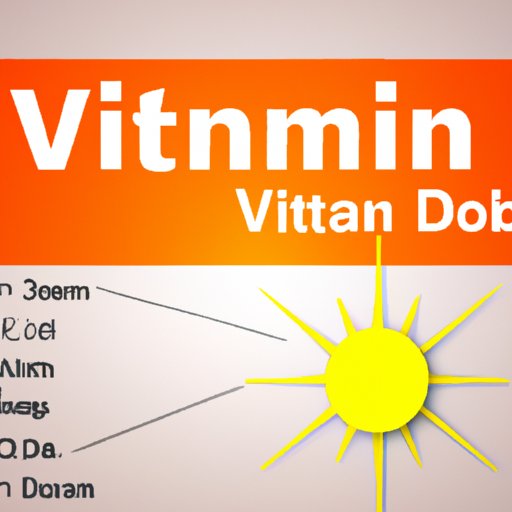
I. Introduction
Do you know that one of the easiest and most accessible ways to get Vitamin D is through sunlight? Yes, you read it right. Beyond being a source of warmth and light, the sun is the primary natural source of Vitamin D. So if you’re wondering how do you get Vitamin D from the sun, you’re in the right place. In this article, we’ll take a closer look at the science, benefits, and risks of natural Vitamin D production through sunlight. Whether you’re a health enthusiast or just someone who loves spending time outdoors, this article will surely be useful for you.
II. What Is Vitamin D and Why Is It Important?
Vitamin D is a fat-soluble vitamin that’s essential to our health. It helps our body absorb calcium, which is vital for bone growth and development. It also plays a role in the proper functioning of the immune system, muscle health, and brain development. Insufficient levels of Vitamin D can lead to serious health problems such as rickets, osteoporosis, and autoimmune diseases.
III. Benefits of Getting Vitamin D from Sunlight
Getting Vitamin D from sunlight has several benefits over supplements or food sources. First, it’s free and accessible. You don’t need to spend money on supplements or special diets to get Vitamin D from sunlight. Secondly, sunlight allows the body to produce Vitamin D naturally. This makes it easier for the body to absorb and use compared to synthetic sources. Thirdly, sunlight exposure has additional health benefits such as improving mood, reducing stress and anxiety, and promoting healthy sleep patterns.
IV. Science Behind How Our Bodies Produce Vitamin D
When the skin is exposed to sunlight, it triggers a chemical reaction that converts a cholesterol compound into Vitamin D3. This Vitamin D3 then enters the bloodstream and travels to the liver and kidneys, where it’s transformed into active Vitamin D. The timing, intensity, and duration of sunlight exposure affect the amount of Vitamin D produced. The best time to get sunlight for Vitamin D production is around midday when the sun is at its highest point. This is because the UVB rays that stimulate Vitamin D production are most abundant during this time.
V. How Much Time in the Sun Is Necessary?
The amount of time needed to get enough Vitamin D from sunlight varies depending on several factors. These include skin tone, latitude, time of day, and season. Generally, it’s recommended to get 10-30 minutes of unprotected sunlight exposure on the arms, legs, back, and face, 2-3 times a week. However, individuals with darker skin or living near the poles may need longer exposure to make enough Vitamin D.
VI. Balancing Risks and Benefits of Sun Exposure
While sunlight is an excellent source of Vitamin D, it’s essential to balance the risks associated with sun exposure. Prolonged and unprotected exposure to the sun’s UV rays can lead to sunburn, premature aging, and skin cancer. To reduce these risks, limit your sun exposure during peak hours of the day, wear protective clothing and use a broad-spectrum sunscreen with at least SPF 30.
VII. Outdoor Activities and Hobbies
Aside from sunbathing, there are other outdoor activities and hobbies that can help you get more sunlight exposure. These include gardening, hiking, swimming, and playing sports. Try to incorporate these activities into your daily routine to increase your Vitamin D levels naturally.
VIII. Other Natural Ways to Boost Vitamin D Levels
If you have limited access to sunlight or live in areas with low sunlight, there are other natural ways to boost your Vitamin D levels. These include eating foods that are fortified with Vitamin D, such as milk, orange juice, and cereal. You can also get Vitamin D from natural food sources such as fatty fish, egg yolks, and mushrooms. Finally, supplements can also help you achieve adequate Vitamin D levels. However, it’s important to consult with a healthcare professional before taking Vitamin D supplements.
IX. Conclusion
In conclusion, getting Vitamin D from sunlight is an easy and accessible way to improve your health naturally. With its multiple benefits and low cost, there’s no reason why you shouldn’t take advantage of the sun’s natural source of Vitamin D. By following the tips and recommendations in this article, you can boost your Vitamin D levels while minimizing the risks associated with sun exposure.





